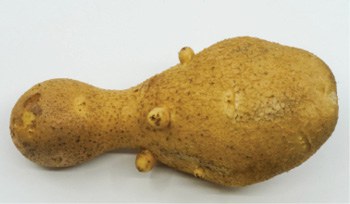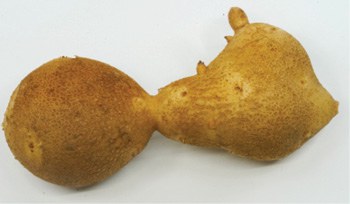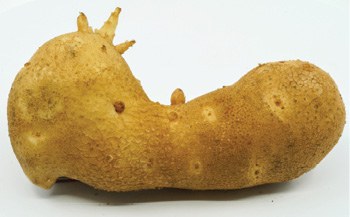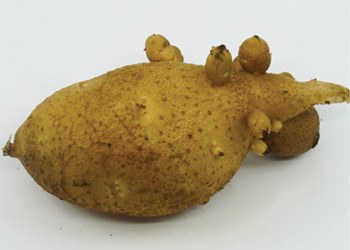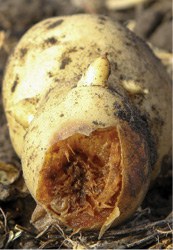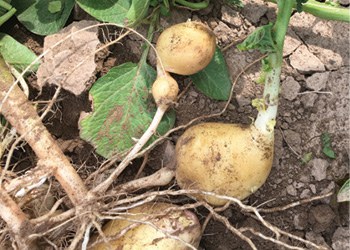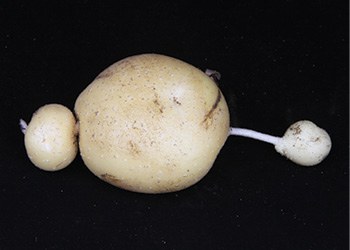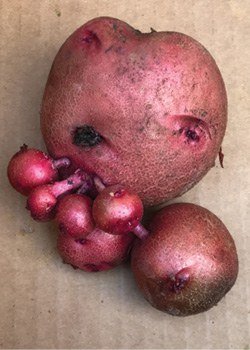Potato tubers are the result of the plant genetics and the environmental conditions in which they are grown. Potato varieties are selected carefully for tubers that have desirable appearance to maximize sales and reduce waste.
However, some years can cause more environmental stress than others, resulting in tuber secondary growth. Secondary growth often manifests as heat sprouts, tuber chaining and tuber malformations. This physiological disorder decreases yield and quality of the tubers in the field.
The most common condition leading to secondary growth is heat stress, specifically soil temperatures. Soil temperature as low as 75 F (24 C) can stimulate this disorder, while soil temperature held at 82 F (28 C) for a month or 90 F (32 C) for one week has resulted in consistent and significant second growth of tubers.
The development of this second growth also can be attributed to other conditions that interrupt or temporally halt growth, such as moisture stress or nutrient imbalance. A combination of stresses, such as heat and moisture stress, will exacerbate plant stress and cause more pronounced second growth.
The size, shape and amount of second growth will depend on the growth stage, variety, and the duration and intensity of the stress. This second growth reduces tuber quality and marketable yield by consuming plant energy for heat sprouts, resulting in misshapen, unmarketable tubers, while not providing any benefit to the grower.
In a stressful period, normal potato tuber growth is interrupted or stopped, and then normal tuber growth resumes. This change in growth can affect how tubers develop. Early bulking stress can constrict stem end growth, resulting in pointy stem end (Figure 1) or bottleneck tubers (Figure 2).
Mid-bulking growth disruption leads to tubers that look like dumbbells (Figure 3), or are kidney-shaped (Figure 4) or elongated (Figure 5). Late-bulking growth disruption can cause pointy bud end tubers (Figure 6).
Tubers with pointy ends, generally those receiving the early bulking stress, may develop jelly end rot (Figure 7) or an accumulation of sugars in the stem end rather than starch that appears translucent. Jelly end rot breakdown results in soft, jellylike and slightly watery ends.
Fusarium can infect jelly ends and appear like dry rot. The affected area may extend up to an inch (2.5 centimeters) or more from the stem end. As the tubers age or dry out, the affected tissue dehydrates, shrivels, and turns light brown and papery. Heat stress also can stimulate growth of lateral buds, resulting in protruding eyes or knobs (Figure 8).
Heat sprouts and chaining of tubers are an outcome of renewed growth following a stress period. Heat sprouts (Figure 9) grow from stolons or tubers and will grow above ground into leafy stems (Figure 10) or below ground as stolons (Figure 11).
Tuber chaining (Figure 12) can occur when stolons set multiple tubers on one stolon. Varieties with short dormancy seem to be more prone to develop heat sprouts and chaining of tubers. This can result in dormancy being broken, causing tubers to sprout prior to harvest. Storing these potato tubers can be difficult because they are physiologically old and often will develop secondary tubers in storage (Figure 13).
Potato second growth is a difficult disorder to avoid because of the strong environmental influence on plant growth and development. To minimize second growth, look for varieties that are less prone to having second growth and try to maintain ideal conditions for uniform plant and tuber growth.
Cultural management practices may include promoting uniform stands, ensuring adequate plant nutrition and promoting uniform soil moisture to meet crop demand. Irrigation can be used to cool the soil, but do not overwater because this can lead to lenticel enlargement and pathogen entry into tubers.
Pointy stem end tuber
Bottleneck-shaped tuber
Dumbbell-shaped tuber
Kidney-shaped tuber with heat sprouts
Elongated tuber
Pointy bud end tuber
Jelly end rot
Protruding eyes or knobs
Heat sprouts
Heat sprouts with foliar growth
Heat sprouts with tuber chaining
Tuber chaining
Second tubers

